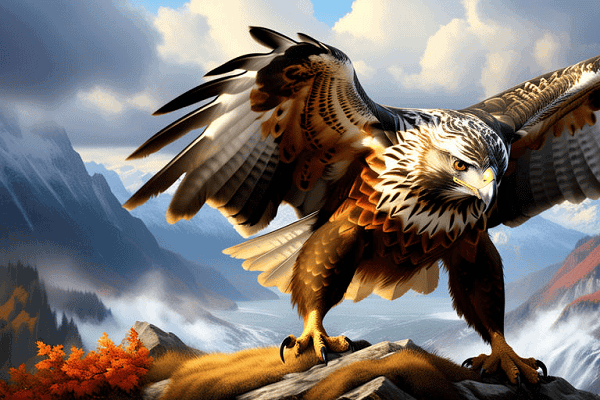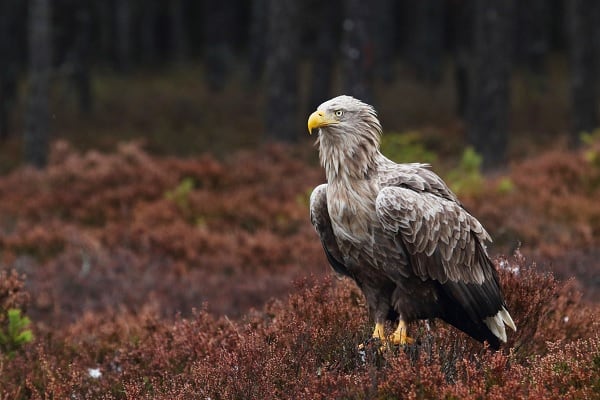Welcome to the majestic world of Alaska’s eagles! Have you ever wondered how to spot the different types of eagles that call Alaska home? Are you curious about their distinct characteristics and habitats? Prepare to be captivated as we uncover the secrets of identifying and observing bald, golden, white-tailed, and steller’s sea eagles in their natural habitat.
Here are the main points:
- Learn how to identify and differentiate between bald, golden, white-tailed, and steller’s sea eagles in Alaska
- Discover where to find these magnificent eagles and increase your chances of spotting them in action
- Explore the nesting habits, preferred food sources, and conservation efforts related to bald eagles
- Delve into the hunting skills, preferred habitats, and unique characteristics of golden eagles
- Uncover the formidable size, distinct features, and fishing abilities of white-tailed eagles along Alaska’s coastlines
The Mighty Bald Eagle
The bald eagle is one of the most iconic birds of North America. With its striking appearance and majestic presence, this magnificent creature has captured the hearts of people across the country. Let’s delve into the fascinating world of the bald eagle and discover some interesting facts about its nesting habits, preferred food sources, and conservation efforts.

Nesting Habits
The bald eagle builds its nests, also known as eyries, in tall trees near bodies of water. These nests are large structures made of sticks and lined with soft materials such as moss and feathers. The eagles tend to return to the same nest year after year, often adding new materials to reinforce and expand it. These nests can reach impressive sizes, with some measuring up to 10 feet in diameter and weighing up to a ton.
Preferred Food Sources
The bald eagle is primarily a fish-eater, and its diet largely consists of fresh and carrion fish. They are skilled hunters, adept at snatching fish from the water’s surface with their sharp talons. Additionally, bald eagles also consume small mammals, waterfowl, and carrion, making them excellent scavengers. They play an essential role in the ecosystem by helping to maintain a healthy balance in the food chain.
Conservation Efforts
The bald eagle’s population faced a significant decline due to habitat loss, hunting, and the widespread use of pesticides like DDT. However, conservation efforts, including habitat protection and the banning of harmful chemicals, have led to a remarkable recovery of the species. Today, the bald eagle is no longer listed as an endangered species, thanks to the collaborative efforts of organizations and individuals dedicated to their preservation.
Related Article Eagles That Found in Texas
Where to Find Them
If you want to catch a glimpse of these magnificent birds in action, Alaska is the place to be. The state boasts one of the largest populations of bald eagles in the world, offering ample opportunities for sightings. Head to locations near rivers, lakes, or coastal areas where the eagles can find an abundance of food. Popular spots include the Chilkat Bald Eagle Preserve, Kachemak Bay, and the Kenai River.
So pack your binoculars, prepare your camera, and embark on an unforgettable journey to observe the mighty bald eagle in its natural habitat.
| Nesting Habits | Preferred Food Sources | Conservation Efforts | Where to Find Them |
|---|---|---|---|
| Nests are built in tall trees near bodies of water Large structures made of sticks and lined with soft materials Eagles often return to the same nest year after year | Primary diet consists of fish Skilled hunters, known for snatching fish from the water’s surface Also consume small mammals, waterfowl, and carrion | Population declined due to habitat loss, hunting, and pesticide use Conservation efforts have led to a remarkable recovery No longer listed as an endangered species | Alaska has one of the largest populations of bald eagles Best chances of spotting them near rivers, lakes, and coastal areas Popular spots include Chilkat Bald Eagle Preserve, Kachemak Bay, and Kenai River |
The Regal Golden Eagle
When it comes to powerful predators, the golden eagle is in a league of its own. Known for its exceptional hunting skills, this regal bird is a sight to behold. Let’s delve into the distinctive features and behaviors that make the golden eagle truly magnificent.

Distinctive Features
The golden eagle is easily recognizable by its large size and striking appearance. With a wingspan that can reach up to seven feet, it is one of the largest raptors in North America. Its feathers boast shades of dark brown, golden brown, and black, giving it a majestic aura.
Behaviors
Golden eagles are known for their remarkable hunting abilities. These birds are skilled predators, capable of taking down prey as large as deer and coyotes. They are also known for their agile flight and can often be seen soaring through the Alaskan skies with grace and precision.
Preferred Habitats
Golden eagles prefer habitats that provide them with ample opportunities to hunt for their prey. They are commonly found in mountainous regions, cliffs, and open grasslands. These birds prefer nesting in elevated areas, such as treetops or rocky ledges.
Tips for Spotting Golden Eagles
- Look for open areas with a high vantage point to spot golden eagles soaring through the sky.
- Golden eagles are often seen near bodies of water, where they can find food and suitable hunting grounds.
- Listen for their distinctive high-pitched calls, which can help you locate these majestic birds.
- Bring a pair of binoculars to enhance your chances of observing the golden eagle in its natural habitat.
Keep in mind that golden eagles are protected under various conservation measures. It’s important to observe them from a respectful distance and avoid disturbing their nesting sites.
Also Read About Eagles in California
Comparing Different Types of Eagles in Alaska
| Eagle Type | Distinctive Features | Habitat | Prey |
|---|---|---|---|
| Bald Eagle | White head, dark brown body; yellow beak and talons | Near water bodies such as rivers, lakes, and coastlines | Fish, small mammals, and waterbirds |
| Golden Eagle | Large size, shades of dark brown and golden brown feathers | Mountainous regions, cliffs, and open grasslands | Small to medium-sized mammals, birds, and reptiles |
| White-Tailed Eagle | Large size, white plumage, and distinctive yellow beak and talons | Coastlines and wetland areas | Fish, waterbirds, and carrion |
| Steller’s Sea Eagle | Massive size, white plumage, and yellow beak and talons | Coastlines and near bodies of water | Fish, waterbirds, and carrion |
White-Tailed Eagle
The white-tailed eagle, also known as the sea eagle, is truly a magnificent sight. With its formidable size, distinct features, and unique hunting techniques, this eagle commands attention.

One of the most striking characteristics of the white-tailed eagle is its impressive wingspan, which can reach up to 8 feet. The combination of its large size and striking white tail feathers make it distinguishable from other eagle species.
When it comes to hunting, the white-tailed eagle is a master of aerial agility. It has been observed using a technique known as “plunging,” where it dives from great heights to catch fish near the water’s surface. This remarkable fishing ability is a sight to behold.
If you want to witness these magnificent eagles in all their glory, head to Alaska’s coastlines. Their preferred habitats along the water provide the perfect vantage points to observe their hunting prowess. Whether you catch a glimpse of them soaring high above the waves or diving into the water to catch their next meal, the white-tailed eagle is a true spectacle of nature.
Comparison of Eagle Species in Alaska
| Eagle Species | Distinct Features | Hunting Techniques | Habitat |
|---|---|---|---|
| Bald Eagle | Brown body and white head, large size | Primarily fish, scavenging | Coastlines, lakes, and rivers |
| Golden Eagle | Brown feathers with golden nape, powerful build | Small mammals and birds | Mountainous and open landscapes |
| White-Tailed Eagle | White tail feathers, formidable size | Plunging from the air to catch fish | Coastlines and wetlands |
| Steller’s Sea Eagle | Dark feathers, massive size | Marine animals and fish | Coastal habitats |
Majestic Steller’s Sea Eagle
When it comes to eagles, the steller’s sea eagle stands out as a true giant in both size and presence. With its striking appearance and awe-inspiring habits, this magnificent bird is a sight to behold in the wilds of Alaska.

The steller’s sea eagle is known for its immense size, often reaching lengths of over 3 feet and weighing up to 20 pounds. Its most distinctive feature is its stark white head, which contrasts sharply with its dark brown body and wings. This regal bird also boasts a powerful beak, perfect for snatching fish from the water with remarkable precision.
The habitat preferences of the steller’s sea eagle make it a truly unique species. While it can be found along the coastal regions of northeastern Asia, it is Alaska where these incredible eagles truly thrive. Their preferred hunting grounds are the remote areas of the Kamchatka Peninsula and the Kuril Islands, where they can take advantage of the abundant fish populations.
“The steller’s sea eagle is a true testament to the grandeur of Alaska’s wilderness. Its massive size and distinctive appearance make it a prized sighting for any bird enthusiast. When you catch sight of this majestic bird soaring through the skies or diving into the water to catch its prey, it’s a truly awe-inspiring experience.
Feeding Habits
As a specialized fish-eater, the steller’s sea eagle primarily feeds on various species of fish found in the coastal waters of Alaska. Its hunting technique involves soaring high above the water, scanning for potential prey, and then swiftly diving with impressive speed and agility to snatch fish with its talons. This exceptional hunting skill often earns it the title of the “fishing eagle.”
While fish make up the majority of its diet, the steller’s sea eagle is known to supplement its meals with other coastal wildlife such as seabirds and even small mammals when the opportunity arises. This adaptability ensures its survival and sustains its impressive size and strength.
| Habitat | Feeding Habits | Physical Characteristics |
|---|---|---|
| Coastal regions of northeastern Asia, particularly the remote areas of the Kamchatka Peninsula and the Kuril Islands | Specialized fish-eater, primarily feeds on various species of fish found in coastal waters | – Striking appearance with a stark white head and dark brown body and wings – Immense size, reaching lengths of over 3 feet and weighing up to 20 pounds – Powerful beak |
Encountering the steller’s sea eagle in its natural habitat is a once-in-a-lifetime experience. So, if you find yourself in the coastal regions of Alaska, keep an eye out for this remarkable bird soaring gracefully through the skies or perched on a coastal tree, commanding the pristine wilderness that is their home.
Final Thoughts
Alaska offers an unparalleled opportunity to witness the beauty and grace of eagles in their natural habitat. By familiarizing yourself with the different types of eagles found in Alaska and their unique characteristics, you can enhance your experience of encountering these magnificent birds. Whether you’re a dedicated bird watcher or simply appreciate the wonders of nature, Alaska’s abundance of eagles will leave you in awe.
Spotting an eagle in flight, witnessing their impressive hunting techniques, or observing their majestic nests in person is a truly unforgettable experience. With its diverse landscapes and vast wilderness, Alaska provides the perfect backdrop for eagle-watching adventures.
So, grab your binoculars, select the best viewing spots, and set off on an extraordinary journey through the stunning wilderness of Alaska. Listen to the distinctive calls of bald, golden, white-tailed, and steller’s sea eagles as you immerse yourself in their world. Whether you’re an experienced bird enthusiast or a first-time observer, Alaska’s eagles will captivate your imagination and ignite a passion for these magnificent creatures.
